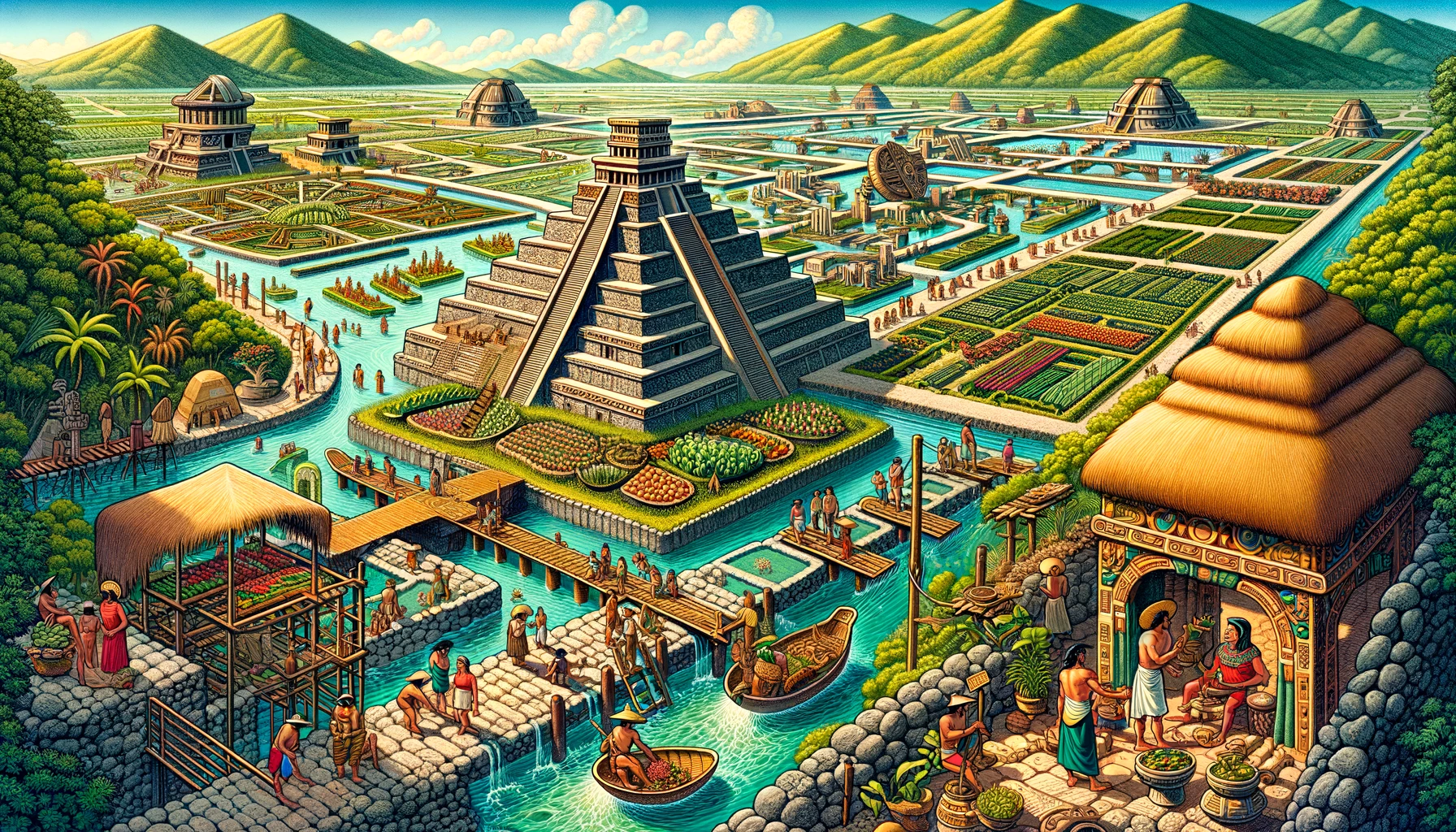
Aztec Technology: Ancient Genius That Still Outsmarts Us
It always starts the same way — you can’t sleep, you’re scrolling, and somehow you fall into a documentary you didn’t plan to watch. Mine was about Aztec technology, and I swear it grabbed me by the collar. One minute I’m half-awake, the next I’m staring at people from six centuries ago building floating gardens and cities on water like it’s no big deal.
I kept thinking, wait … how? No engines, no steel, not even wheels. Just hands, mud, stone — and somehow, brilliance.
The deeper I went, the more it felt like the Aztecs weren’t “ancient” at all. They were just a civilization that figured out things we’re still trying to relearn: balance, sustainability, respect.
Living With the Land, Not Against It
So, picture this — you’re stuck in the middle of a swampy basin surrounded by volcanoes and unpredictable weather. Most of us would move. The Aztecs? They stayed … and adapted.
They looked around and thought, Alright, this isn’t easy, but let’s make it work. That attitude still gives me chills. It’s like their entire technology was built on stubborn optimism.
They didn’t have the word “eco-friendly,” but everything they built was exactly that.
Chinampas – Floating Gardens That Fed a Nation
Okay, this part actually made me pause the video. The Aztecs invented chinampas — man-made floating fields woven from reeds, filled with mud and compost. Whole farms, literally floating on water.
From above, it must’ve looked unreal — rectangles of green surrounded by blue, criss-crossed with tiny canals. Farmers in canoes gliding between them, hauling corn and squash. You could almost hear the splash of paddles.
And here’s the kicker: those fields never dried out, never flooded. They recycled nutrients naturally. It’s ancient hydroponics. Smart, quiet, efficient.
Some people near Xochimilco still use chinampas today. I Googled it twice just to make sure that was real. Seven hundred years later, the system still works. That’s what you call timeless tech.
Tenochtitlán – The City That Floated
Their capital, Tenochtitlán, might be my favorite part of this story. Imagine walking into a city built on a lake — stone temples, markets, gardens — and it’s all shimmering over water.
Spanish explorers wrote that it looked like something out of a dream. And honestly, who could blame them? There were wide causeways, liftable bridges, aqueducts that carried clean water from miles away.
No concrete. No cranes. Just math, sweat, and imagination.
Sometimes I look at modern cities that flood after one storm and think, we could use a few Aztecs on the planning team.
Obsidian – Sharper Than Steel
Here’s something wild: the Aztecs had no iron, no bronze. Instead, they used obsidian, volcanic glass. Sounds fragile, right? Nope. It’s sharper than surgical steel.
They shaped it into knives, chisels, arrowheads — even weapons like the macuahuitl, a wooden club edged with glassy blades. Imagine sunlight flashing off that in battle. Elegant and terrifying.
Their tools weren’t primitive; they were precise. Obsidian could slice flesh cleaner than any metal blade. It still blows my mind that something so beautiful could be so deadly … and so useful.
Astronomy – The Original Cosmic Calendar
At some point that night, I looked out my window and tried to imagine what the Aztecs saw when they looked up. No city lights, no pollution — just stars, endless and bright.
They mapped them by hand. With nothing but patience and pattern. Their calendars were insane — a 365-day solar one for farming and a 260-day ritual one for religion. Those two spun together like gears, syncing every 52 years in what they called the “binding of the years.”
To them, it wasn’t just about dates. It was destiny — when time reset, when cycles began again. They built temples perfectly aligned with the sun, tracked eclipses, and planned harvests from the sky.
We check weather apps; they read the universe.
Medicine – Healing the Body and the Spirit
Another surprise? They weren’t just warriors and builders; they were healers.
Their doctors, called ticitl, used hundreds of herbs — aloe, chili, cacao, sage — to treat everything from fever to heartbreak. They even performed surgeries with obsidian scalpels. Precise cuts. Minimal infection. All without anesthesia or microscopes.
But it wasn’t just physical. They believed sickness came from imbalance — inside you, around you, between you and the gods. So healing meant restoring harmony.
It’s kinda poetic, right? They treated people, not problems.
Weapons and Warfare – Art in Motion
The Aztecs were warriors, yeah, but not brutes. Everything was structured — rituals, strategy, purpose.
Their atlatl (a spear thrower) gave throws crazy speed and distance. Armor made from salt-soaked cotton could stop arrows. Even their formations followed sacred geometry.
They fought not just for land but for balance — for cosmic order. Sounds dramatic, but to them, war kept the world in motion.
And somehow, I get that. Every civilization fights for something. Theirs just happened to be the sun.
Everyday Tech That Actually Matters
It’s easy to forget that technology isn’t always flashy. The Aztecs proved that.
In their homes you’d find metates for grinding corn, comales for cooking tortillas, petates — woven mats — for sleeping or keeping cool. Simple, useful, human.
They wrote in codices, colorful pictographic books that told stories of gods, kings, and stars. No alphabet, no printing press — just symbols and patience.
And still, somehow, their knowledge survived centuries.
Eco Before Eco Was Cool
What really hit me was how sustainable their whole world was.
They recycled water. Reused waste. Managed forests carefully. Even their religion reminded them to give thanks for every harvest. Nothing was taken without giving back.
We talk about “green architecture” now like it’s new. The Aztecs lived it daily.
Maybe progress isn’t about inventing new ways to dominate nature. Maybe it’s remembering not to.
What Aztec Technology Teaches Us Now
After that deep dive, I couldn’t shake one thought: they didn’t just build things — they built systems that worked with nature instead of against it.
Their farms fed thousands without chemicals. Their city stayed clean without pipes. Their calendar kept people aligned with seasons, not spreadsheets.
We build skyscrapers and call it success. They built harmony and called it survival.
If we borrowed even half their mindset, maybe cities would breathe again.
FAQs About Aztec Technology
Q1: What was the most important Aztec invention?
Probably the chinampas — those floating gardens that turned a swamp into farmland. They kept food coming year-round.
Q2: Did the Aztecs really have writing?
Yep. They recorded everything in codices — folded books painted on bark or skin, filled with colorful pictographs.
Q3: How did they build without metal tools?
With obsidian and determination. Obsidian could carve stone like butter if handled right.
Q4: Is any of their technology still used today?
Sure is. Chinampa farming still exists near Mexico City, and modern engineers study Aztec water management for sustainable design ideas.
Final Thoughts – The Ancient Blueprint for Tomorrow
By the time I shut my laptop, the sky outside had started turning gray. Birds waking up, city still quiet. And I just sat there thinking how people from half a millennium ago might’ve known more about living than we do now.
Aztec technology wasn’t about gadgets. It was about understanding. They didn’t separate invention from intention — everything they built served life, not the other way around.
We chase “innovation” like it’s a trophy. They practiced it like a prayer.
Maybe that’s the difference. They built for survival and soul. We could learn from that — if we’re humble enough to listen.
Because sometimes the future isn’t ahead of us. It’s waiting in the past, quietly reminding us how to live well again.




